
A knot is an intentional complication in cordage which may be practical or decorative, or both. Practical knots are classified by function, including hitches, bends, loop knots, and splices: a hitch fastens a rope to another object; a bend fastens two ends of a rope to each another; a loop knot is any knot creating a loop; and splice denotes any multi-strand knot, including bends and loops. A knot may also refer, in the strictest sense, to a stopper or knob at the end of a rope to keep that end from slipping through a grommet or eye. Knots have excited interest since ancient times for their practical uses, as well as their topological intricacy, studied in the area of mathematics known as knot theory.
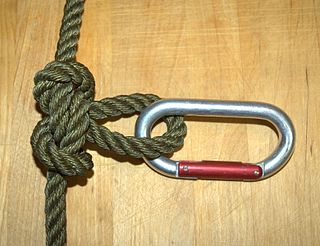
The butterfly loop, also known as lineman's loop, butterfly knot, alpine butterfly knot, Swiss loop and lineman's rider, is a knot used to form a fixed loop in the middle of a rope. Tied in the bight, it can be made in a rope without access to either of the ends; this is a distinct advantage when working with long climbing ropes. The butterfly loop is an excellent mid-line rigging knot; it handles multi-directional loading well and has a symmetrical shape that makes it easy to inspect. In a climbing context it is also useful for traverse lines, some anchors, shortening rope slings, and for isolating damaged sections of rope.

The Eskimo bowline, Cossack knot, reverse bowline, or 'anti-bowline' is in a class of knots known as 'eye knots' or 'loop knots'. The eye is formed in the end of the rope to permit attachments/connections. It is quite common in Russia and is often used instead of the bowline. In the simple bowline, the collar component forms around the 'standing part'. In contrast, the collar component of an Eskimo bowline forms around the outgoing eye-leg.
A whipping knot or whipping is a binding of marline twine or whipcord around the end of a rope to prevent its natural tendency to fray.
A versatackle is a self-locking tensioning structure implemented in cordage. It consists of two loops with the rope passed back and forth between them. It is functionally similar to the trucker's hitch, however, unlike the trucker's hitch, the versatackle is self-locking under tension.

The dropper loop is a type of loop knot often used on multi-hook fishing lines. It can be created in the middle of a long line and forms a loop which is off to the side of the line.

The butterfly bend is a knot used to join the ends of two ropes together. It is the analogous bend form of the butterfly loop, in that it is the butterfly loop with the loop cut. The observation that the butterfly loop is secure enough to isolate a worn or damaged section of rope within the loop indicated that the bend form of the knot would be similarly secure.
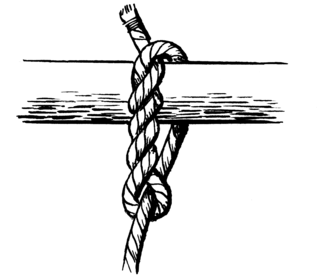
The timber hitch is a knot used to attach a single length of rope to a cylindrical object. Secure while tension is maintained, it is easily untied even after heavy loading.

The artillery loop is a knot with a loop on the bight for non-critical purposes. The artillery loop must have the loop loaded or it will slip and contract easily. It is an inferior knot to the alpine butterfly knot, possibly dangerously so, in that it can be yanked out of shape and turn into a running knot or noose.
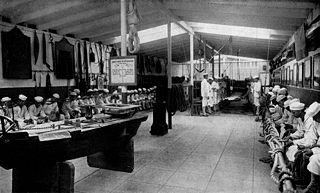
Ropework or marlinespike seamanship are traditional umbrella terms for a skillset spanning the use, maintenance, and repair of rope. Included are tying knots, splicing, making lashings, whippings, and proper use and storage of rope.
Kernmantle rope is rope constructed with its interior core protected by a woven exterior sheath designed to optimize strength, durability, and flexibility. The core fibers provide the tensile strength of the rope, while the sheath protects the core from abrasion during use. This is the only construction of rope that is considered to be life safety rope by most fire and rescue services.

The adjustable grip hitch is a simple and useful friction hitch which may easily be shifted up and down the rope while slack. It will hold fast when loaded, but slip when shock loaded until tension is relieved enough for it to again hold fast. It serves the same purpose as the taut-line hitch, e.g. tensioning a tent's guy line.

The Albright special or Albright knot is a bend used in angling. It is a strong knot used to tie two different diameters of line together, for instance to tie monofilament to braid. The Albright is relatively smooth and passes through guides when required. Some anglers coat the knot with a rubber based cement to make it even smoother and more secure.

The Ashley Book of Knots is an encyclopedia of knots written and illustrated by the American sailor and artist Clifford W. Ashley. First published in 1944, it was the culmination of over 11 years of work. The book contains 3,854 numbered entries and approximately 7,000 illustrations. The entries include knot instructions, uses, and some histories, categorized by type or function. It remains one of the most important and comprehensive books on knots.

The adjustable bend is a bend knot that is easy to lengthen or shorten.

The Bimini twist is a fishing knot used for offshore trolling and sportsfishing and the creation of double-line leaders. A Bimini twist creates a loop at the end of the line in which it is tied. The loop secured at the top with a long barrel of coiled line created by the tying process. A Bimini twist loop is stronger than the line itself. It is one of the rare knots that does not weaken the line in which it is tied. It is a simple method of doubling your fishing line in order to prevent chafing or to create the necessary loop in order to attach a wind-on leader without using strength in the mainline. For use in fishing applications, the old stand by is 20-30 initial twists in nylon monofilament and 60 or more initial-twists in Spectra-type braided line.
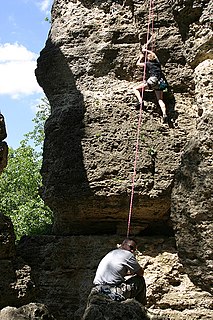
A climbing rope is a rope that is used in climbing. It is a critical part of an extensive chain of protective equipment used by climbers to help prevent potentially fatal fall-related accidents.
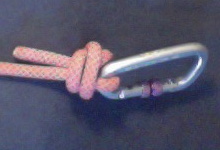
The double overhand noose is a very secure hitch knot. It might be used by cavers and canyoneers to bind a cow tail or a foot loop to a carabiner.

The Reever Knot is a secure bend for joining two ropes. An important attribute of the knot is that each line going in and out of the knot is clamped at two points within the knot. For this reason it is considered secure and resistant to being shaken loose when subject to intermittent loads.

















